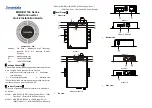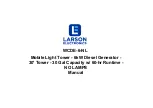
6 | SAMLEX AMERICA INC.
SAMLEX AMERICA INC. | 7
effect is a tendency to cancel each other. Hence, in a circuit containing both inductances
and capacitances, the net Reactance (X) will be equal to the difference between the
values of the inductive and capacitive reactances. The net Reactance (X) will be inductive
if X
L
> X
c
and capacitive if X
c
> X
L
.
impedance, Z: It is the vectorial sum of resistance and reactance vectors in a circuit.
Active Power (P), Watts: It is denoted as “P” and the unit is “Watt”. It is the power that
is consumed in the resistive elements of the load. A load will require additional Reactive
Power for powering the inductive and capacitive elements. The effective power required
would be the Apparent Power that is a vectorial sum of the Active and Reactive Powers.
Reactive Power (Q), VAR: Is denoted as “Q” and the unit is VAR. over a cycle, this power
is alternatively stored and returned by the inductive and capacitive elements of the load.
It is not consumed by the inductive and capacitive elements in the load but a certain
value travels from the AC source to these elements in the (+) half cycle of the sinusoidal
voltage (Positive value) and the same value is returned back to the AC source in the (-)
half cycle of the sinusoidal voltage (Negative value). Hence, when averaged over a span
of one cycle, the net value of this power is 0. However, on an instantaneous basis, this
power has to be provided by the AC source. Hence, the inverter, AC wiring and over cur-
rent protection devices have to be sized based on the combined effect of the Active and
Reactive Powers that is called the Apparent Power.
Apparent (S) Power, VA: This power, denoted by "S", is the vectorial sum of the Active
Power in Watts and the Reactive Power in “VAR”. In magnitude, it is equal to the RMS
value of voltage “V” X the RMS value of current “A”. The Unit is VA. Please note that
Apparent Power VA is more than the Active Power in Watts. Hence, the inverter, AC wir-
ing and over current protection devices have to be sized based on the Apparent Power.
Power Factor, (PF): It is denoted by “Pf” and is equal to the ratio of the Active Power
(P) in Watts to the Apparent Power (S) in VA. The maximum value is 1 for resistive types
of loads where the Active Power (P) in Watts = the Apparent Power (S) in VA. It is 0 for
purely inductive or purely capacitive loads. Practically, the loads will be a combination of
resistive, inductive and capacitive elements and hence, its value will be > 0 <1. Normally
it ranges from 0.5 to 0.8.
Load: electrical appliance or device to which an electrical voltage is fed.
Linear Load: A load that draws sinusoidal current when a sinusoidal voltage is fed to it.
Examples are, incandescent lamp, heater, electric motor, etc.
non-Linear Load: A load that does not draw a sinusoidal current when a sinusoidal volt-
age is fed to it. for example non-power factor corrected Switched Mode Power Supplies
(SMPS) used in computers, audio video equipment, battery chargers, etc.
Resistive Load: A device or appliance that consists of pure resistance (like filament
lamps, cook tops, toaster, coffee maker etc.) and draws only Active Power (Watts) from
seCtIOn 2 |
General Information
Содержание PST-600-12
Страница 47: ...SAMLEX AMERICA INC 47 NOTES ...








































